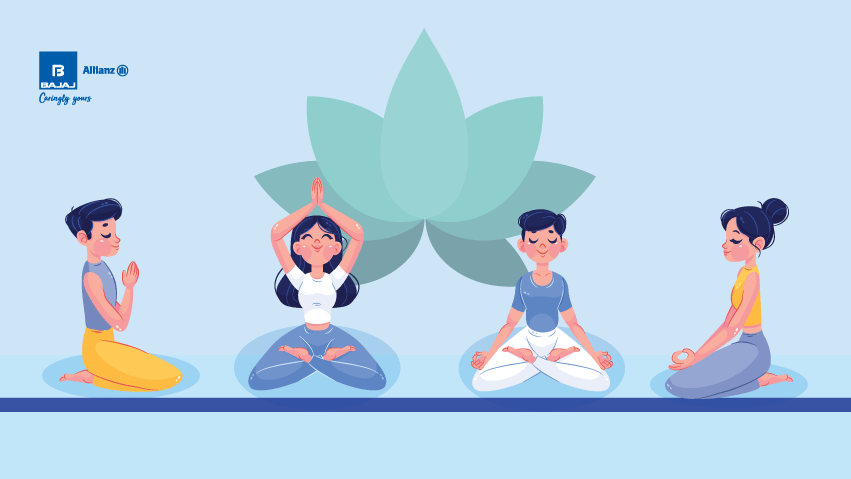Practicing yoga asanas in sitting position is a great way to improve flexibility and stability while maintaining a calm and focused mind. These poses can be performed by beginners and advanced practitioners alike. In this blog, we'll explore 5 sitting yoga asanas and their benefits.
1. Easy Pose (Sukhasana)
Sukhasana, also known as an easy pose, is often the first pose taught in yoga classes. It's a simple cross-legged position that promotes relaxation and meditation.
Benefits of Sukhasana:
- Improves flexibility in the hips and knees.
- Promotes relaxation and a calm mind.
- Enhances posture by encouraging a straight spine.
- Supports mindfulness practices, making it a great start for meditation.
How to Perform Sukhasana:
- Sit on your yoga mat with your legs extended.
- Cross your legs at the shins.
- Keep your back straight and shoulders relaxed.
- Rest your hands on your knees, palms facing up or down.
- Close your eyes and breathe deeply.
2. Diamond Pose (Vajrasana)
Vajrasana, or Diamond Pose, is one of the basic sitting position asanas. It's often used for meditation and pranayama (breathing exercises).
Benefits of Vajrasana:
- Improves digestion and reduces gas.
- Strengthens the thighs and knees.
- Enhances blood circulation in the lower abdomen.
- Alleviates back pain by improving posture.
How to Perform Vajrasana:
- Kneel on the yoga mat with your knees together.
- Sit back on your heels with your toes pointing backward.
- Keep your back straight and shoulders relaxed.
- Place your hands on your thighs, palms facing down.
- Close your eyes and breathe deeply.
3. Staff Pose (Dandasana)
Dandasana, or Staff Pose, is a foundational yoga asana in sitting position. It looks simple but requires attention to alignment.
Benefits of Dandasana:
- Strengthens the core muscles.
- Improves flexibility in the legs and spine.
- Promotes better posture and alignment.
- Increases body awareness.
How to Perform Dandasana:
- Sit on the yoga mat with your legs extended in front of you.
- Flex your feet and engage your thigh muscles.
- Place your hands on either side of your hips, palms pressing into the floor.
- Keep your back straight and shoulders relaxed.
- Gaze forward and breathe deeply.
4. Bound Angle Pose (Baddha Konasana)
Baddha Konasana, also known as Butterfly Pose or Bound Angle Pose, is a great hip opener and one of the effective sitting yoga asanas.
Benefits of Baddha Konasana:
- Improves flexibility in the hips and inner thighs.
- Reduces menstrual discomfort.
- Alleviates sciatica pain.
- Enhances blood circulation to the pelvic region.
How to Perform Baddha Konasana:
- Sit on the yoga mat with your legs extended.
- Bend your knees and bring the soles of your feet together.
- Pull your heels close to your pelvis.
- Hold your feet with your hands and gently press your knees toward the floor.
- Keep your back straight and breathe deeply.
5. Head to Knee Pose (Janu Sirsasana)
Janu Sirsasana, or Head to Knee Pose, is a beneficial sitting posture asana that stretches the back and hamstrings.
Benefits of Janu Sirsasana:
- Stretches the hamstrings and calves.
- Improves flexibility in the spine.
- Stimulates the liver and kidneys.
- Relieves anxiety and stress.
How to Perform Janu Sirsasana:
- Sit on the yoga mat with your legs extended.
- Bend your left knee and place the sole of your left foot against your right thigh.
- Inhale and lift your arms overhead.
- Exhale and fold forward over your right leg, reaching for your foot or ankle.
- Keep your back straight and breathe deeply.
- Repeat on the other side.
Conclusion
Practicing sitting asanas regularly can lead to better physical and mental health. However, it's essential to be prepared for any health emergencies.
Health insurance provides financial protection and peace of mind in case of unexpected medical situations. Consider getting a tailored health insurance plan from Bajaj Allianz General Insurance Company that meets your needs to complement your healthy lifestyle.
By incorporating these 5 sitting yoga asanas into your routine, you can experience numerous benefits and improve your overall well-being. Remember to practice regularly and listen to your body to avoid injuries.
Stay healthy and enjoy your yoga practice!
*Standard T&C Apply
**Disclaimer: The content on this page is generic and shared only for informational and explanatory purposes. It is based on several secondary sources on the internet and is subject to changes. Please consult an expert before making any related decisions.
***Insurance is the subject matter of solicitation. For more details on benefits, exclusions, limitations, terms, and conditions, please read the sales brochure/policy wording carefully before concluding a sale.
****The information presented is not meant to be a substitute for medical advice. Any suggestions mentioned should be considered for general use only. For expert guidance on any health ailment or medical issue or any treatment/procedure, please consult a certified
 Service Chat:
Service Chat: 

